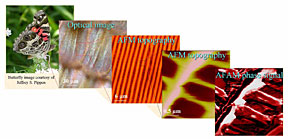| Research
|
|
|||||||||||||||||||||||
|
Check out symmetry—the
|
New microcopy advances biological imaging to nanoscale
Scanning probe microscopes, usually applied to imaging inorganic materials at nano- to microscopic scales, may soon be giving researchers new insights into the biomechanical structures and functions of living organisms.for example, nature's engineering of a butterfly's wing. Sergei Kalinin, a Eugene P. Wigner Fellow at DOE's Oak Ridge National Laboratory, and Alexei Gruverman, a research professor at North Carolina State University, have obtained images of the structure of a Vanessa virginiensis (American Lady) butterfly's wing at approximately 10 nanometer resolution. Their experiment demonstrates that emerging advances in scanning probe microscopy can be applied to more than hard inorganic materials such as superconductors and semiconductors. Although the images are .a proof of concept. it is a concept that could eventually provide clues to the functionality of complex hierarchical biological systems such as bones, teeth and other biological tissues. Nevertheless, even the early results provide clues to the complex structure behind the elasticity and relative durability of the splendidly functional butterfly wing. .Scanning probe microscopy provides unlimited opportunities for understanding material structure, properties, and functionality at all length scales,. says Kalinin . .This will pave the way to better and cheaper materials for biological and medical applications.. Kalinin's and Gruverman's work with imaging biological systems has its roots in the development of atomic force microscopy in the 1980s. Now they are using a technique called Atomic Force Acoustic microscopy, AFAM, which uses tiny blasts of sound to probe not only the surface but also the subsurface structures of delicate biological materials, with approximately five nanometer resolution. .This improved imaging sheds lights on how biological systems work, down to the five-nanometer resolutions, which is comparable to the size of a DNA molecule-about as small as you need for biological materials,. says Kalinin. .Biosystems, because they are not ordered like, for instance, crystalline materials, require real-space imaging of local elastic properties and structure. Scanning probe microscopes are a wonderful tool that is suited for exactly this purpose.. .Scanning probe microscopy is a key to the advancement of nanoscience,. says Kalinin . .It is a new field and it develops rapidly, so novel methods appear virtually overnight. However, it takes a sustained interdisciplinary effort before true potential of SPM is realized..Submitted by DOE's Oak Ridge National Laboratory |




